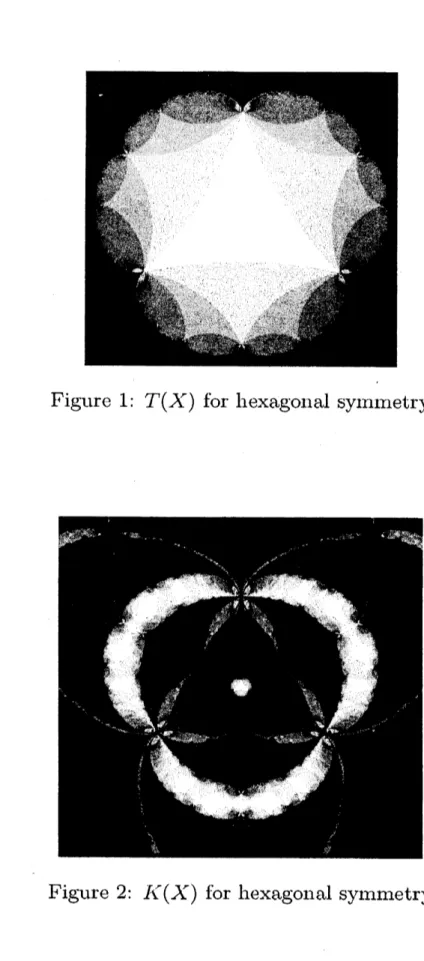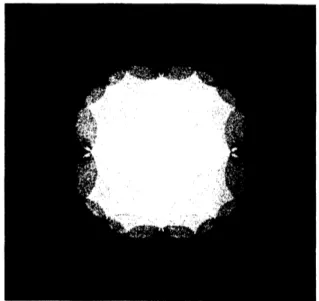Drawing
the
complex projective
structures
on
once-punctured tori
Yohei Komori
(Osaka
City
Univ.)
1
Introduction
This report is based
on
my talk at RIMS International Conference on “Geom-etry Related to Integrable Systems) organized by Reiko Miyaoka. In my talk
I showed many interesting pictures of one-dimensional Teichm\"uller spaces
and related spaces created by Yasushi Yamashita (Nara Women’s Univ.)
which were already appeared in [3]. In this report I would like to explain the
background of these pictures, which
are
explainedmore
extensively in [2].I would like to thank Yasushi Yamashita for his kind assistance with
com-puter graphics, and Yoshihiro Ohnita for his constant encouragement for
me
to write this report.
2
Definition
of
$T(X)$Let $X$ be a Riemanm surface of genus $g$ with $n$ punctures. Here we
assume
that $X$ is uniformized by the upper half plane $\mathbb{H}$ in $\mathbb{C}$, which implies the
inequality
$2g-2+n>0$
.
The Teichmuller space $T(X)$ of $X$ is the setof equivalent classes of quasi-conformal homeomorphisms from $X$ to other
Riemann surface $Y,$ $f$ : $Xarrow Y$: two maps $f_{1}$ : $Xarrow Y_{1}$ and $f_{2}$ : $Xarrow Y_{2}$
are
equivalent if $f_{2}\circ f_{1}^{-1}$ : $Y_{1}arrow Y_{2}$ is homotopic toa
conformal map. If weassume $f$ : $Xarrow Y$ as a quasi-conformal deformation of $X,$ $T(X)$ can be
considered
as
the space of quasi-conformal deformations of $X$.
We will consider
a
complex manifold structureon
$T(X)$, embed itholo-morphically into complex affine space and try to draw its figure. For this
purpose, we give another characterization of $T(X)$ due to Ahlfors and Bers
3
Complex
structure on
$T(X)$Let $\Gamma\subset PSL_{2}(\mathbb{R})$ be a Fuchsiaii groupuniforniizing$X=\mathbb{H}/\Gamma$. A measurable
function $\nu(z)$ on the Riemann sphere $\mathbb{C}P^{1}$ whose essential
$\sup$ norm is less
than 1 is called a Beltrami
differential
for $\Gamma$ if$\mu$ is equal to $0$ on the lower
half plane $\mathbb{L}$ in $\mathbb{C}$ and satisfies
$\mu(\gamma(z))\cdot\overline{\frac{\gamma’(z)}{\gamma’(z)}}=\mu(z)$
for all $z\in \mathbb{C}P^{1}$ and $\gamma\in\Gamma$. This functional equality implies that
$\mu$
on
$\mathbb{H}$
is a lift of $(-1,1)$ form on X. We denote the set of Beltrami
differentials
by$B_{1}(\Gamma, \mathbb{H})$ which has
a
structure of a unit $b\mathfrak{N}$ of complex Banach space. Themeasurable Riemann’s mapping theorem due to Ahlfors and Bers guarantees
that for any $\mu\in B_{1}(\Gamma, \mathbb{H})$ there exists
a
quasi-conformal map $f^{\mu}$ : $\mathbb{C}P^{1}arrow$ $\mathbb{C}P^{1}$ such that$f^{\mu}$ satisfies the Beltrami equation $\frac{\partial f^{\mu}}{\partial\overline{z}}(z)=\mu(z)\frac{\partial f^{\mu}}{\partial z}(z)$.
Also $f^{\mu}$ is unique up to post-composition by M\"obius transformations.
Here we have two remarks: (i) $f^{\mu}$ is conformal on $\mathbb{L}$. (ii) The
quasi-conformal conjugation of$\Gamma$ by $f^{\mu},$ $\Gamma^{\mu}=f^{\mu}\Gamma(f^{\mu})^{-1}$ is also a discrete subgroup
of $PSL_{2}(\mathbb{C})$ acting conformally on $f^{\mu}(\mathbb{H})$.
Now we say $\mu_{1}\sim\mu 2$ for $\mu_{1},$ $\mu_{2}\in B_{1}(\Gamma, \mathbb{H})$ if $\Gamma^{\mu 1}=\Gamma^{\mu 2}$. Then $T(X)$
can
be identified with the quotient space $B_{1}(\Gamma,\mathbb{H})/\sim$as
follows: For any $[\mu]\in B_{1}(\Gamma, \mathbb{H})/\sim$,we
havea
quasi-conformal deformation of $X$$f^{\mu}:X=\mathbb{H}/\Gammaarrow f^{\mu}(\mathbb{H})/\Gamma^{\mu}$
which defines apoint of$T(X)$. $T(X)$ becomes acomplexmanifold of$dim_{C}T(X)=$
$3g-3+n$ through the complex structure of $B_{1}(\Gamma, \mathbb{H})$. We will embed $T(X)$
holomorpliically into the complex linear space by
means
of complexprojec-tive structures on $\overline{X}$, the
mirror image of $X$ which will be explained in the
next section.
4
Complex
projective
structures
on
$\overline{X}$Let $S$ be
a
surface. A complex projective structure, so called $\mathbb{C}P^{1}$-structureelementsof$PSL_{2}(\mathbb{C})$
are
holomorphic, any $\mathbb{C}P^{1}$-structure on $S$ determinesits
underlying complex structure. Suppose we consider a $\mathbb{C}P^{1}$-structure whose
underlying complex structure is equal to $\overline{X}=\mathbb{L}/\Gamma$, the mirror image of
X. For a local coordinate fumction of this $\mathbb{C}P^{1}$-structure, we
can
take itsanalytic continuation along any
curve
on $\overline{X}$ and havea
multi-valued locally
univalent holomorphic map from $\overline{X}$ to $\mathbb{C}P^{1}$. This map is lifted to $\mathbb{L}$ a locally
uiiivalent meromorphic function $W:\mathbb{L}arrow \mathbb{C}P^{1}$ called the developing map of
this $\mathbb{C}P^{1}$-structure. It is uniquely determined by the $\mathbb{C}P^{1}$-structure up to
post-composition by M\"obius transformations.
When we take
an
analytic continuation of a local coordinate functionalong
a
closedcurve
on $\overline{X}$ andcome
back tothe initial point, it differs
from the previous
one
by a M\"obius transformation since the transition mapsare
in $PSL_{2}(\mathbb{C})$. Consequently we have a homomorphism$\chi$ : $\Gamma\cong\pi_{1}(\overline{X})arrow$
$PSL_{2}(\mathbb{C})$ wliichis called the holonomy representation and satisfies $\chi(\gamma)oW=$ $W\circ\gamma$ for all $\gamma\in\Gamma$
.
Therefore the $\mathbb{C}P^{1}$-structureon
$\overline{X}$ determinesthe pair $(W, \chi)$ up to the action of $PSL_{2}(\mathbb{C})$ and vice
versa.
Herewe
show themost basic example of $\mathbb{C}P^{1}$-structures on $\overline{X}$: Let $W$ be the identity
map
$W:\mathbb{L}\hookrightarrow \mathbb{C}P^{1}$ and
$\chi$ also be the identity homomorphism $\chi$ : $\Gammaarrow\rangle PSL_{2}(\mathbb{R})$
which induces a local coordinate function as a local inverse of the universal
covering map$\mathbb{L}arrow\overline{X}$. We call this $\mathbb{C}P^{1}$-structure the standard$\mathbb{C}P^{1}$-structure
on $\overline{X}$.
Let $P(\overline{X})=\{(W, \chi)\}/PSL_{2}(\mathbb{C})$ be the set of $\mathbb{C}P^{1}$-structures on $\overline{X}$.
We willparametrize $P(\overline{X})$ by holomorphic quadratic differentials on $\overline{X}$ as follows:
A holomorphic fumction $\varphi$ on
$\mathbb{L}$ is called a holomorphic quadratic
differential
for $\Gamma$ if it satisfies
$\varphi(\gamma(z))\gamma’(z)^{2}=\varphi(z)$
for all $z\in \mathbb{L}$ and $\gamma\in\Gamma$. It is
a
lift of holomorphic quadratic differentialson $\overline{X}=\mathbb{L}/\Gamma$. Let $Q(\overline{X})$ be the set of holomorphic quadratic differentials for
$\Gamma$ whose hyperbolic
$\sup$ norm $|| \varphi||=\sup_{z\in L}|\Im z|^{2}|\varphi(z)|$ is bounded. $Q(\overline{X})$
has a structure of complex linear space of $dim_{C}Q(\overline{C})=3g-3+n$ which is
equal to the dimension of $T(X)$
.
We show that there isa
canonical bijectionbetween $P(\overline{X})$ and $Q(\overline{X})$ which maps the standard $\mathbb{C}P^{1}$-structure to the
origin: Given a $\mathbb{C}P^{1}$-structures on $\overline{X}$, take the Schwarzian derivative
of $W$ $S_{W}:=(f’’/f’)’- \frac{1}{2}(f’’/f’)^{2}$
which is
an
element of $Q(\overline{X})$. Conversely given a holomorphic quadraticdifferential $\varphi$ for
$\Gamma$, solve the differential equation
to find the solution $f$, we consider the following linear homogeneous ordinary
differential equation of the second order
$2\eta’’+\varphi\eta=0$
on $\mathbb{L}$. Since $\mathbb{L}$ is simply connected,
a
unique solution$\eta$ exists on
$\mathbb{L}$ for the
given initial data $\eta(-i)=a$ and $\eta’(-i)=b$. Let $\eta_{1}$ and $\eta_{2}$ be the solution
defined by the conditions $\eta_{1}(-i)=0$ and $\eta_{1}’(-i)=1$, and $\eta_{2}(-i)=1$ and
$\eta_{2}’(-i)=0$. Then the ratio $f_{\varphi}=\eta_{1}/\eta 2$ is
a
locally univalent meromorphic$f\iota mction$ on $\mathbb{L}_{7}$ the developing map associated with
$\varphi$. A direct computation
shows that $\eta(\gamma(z))(\gamma’(z))^{-\frac{1}{2}}$ also satisfies the above equation hence there is
a
matrix of $SL_{2}(\mathbb{C})$ such that$(\begin{array}{l}\eta 1(\gamma(z))(\gamma^{/}(z))^{-\frac{1}{2}}\eta 2(\gamma(z))(\gamma^{/}(z))^{-\frac{l}{2}}\end{array})=(\begin{array}{ll}a bc d\end{array})(\begin{array}{l}\eta_{1}\eta_{2}\end{array})$
for all $\gamma\in\Gamma$
.
As a resultwe
havea
homomorphism$\chi_{\varphi}$ : $\Gammaarrow PSL_{2}(\mathbb{C})\}$ the
holonomy representation associated with $\varphi$. We
can
also consider $\chi_{\varphi}$as
themonodromy representation of the above differential equation.
5
Bers embedding of
$T(X)$Now
we
embed $T(X)$ into $Q(\overline{X})\cong \mathbb{C}^{3g-3+n}$ bymeans
of the identification$P(\overline{X})\cong Q(\overline{\lambda’}\cdot)$. For each element $[\mu]\in T(X)=B_{1}(\Gamma, \mathbb{H})/\sim,$ $f^{\mu}|_{L}$ is
confor-mal and $\Gamma^{\mu}=f^{\mu}\Gamma(f^{\mu})^{-1}$ is a quasi-fuchsian group. Therefore it determines
a $\mathbb{C}\mathbb{P}^{1}$-structure
on
$\mathbb{L}/\Gamma$ where the developing map is $W=f^{\mu}|_{L}$ and the
holonomy representation $\chi$ : $\Gammaarrow\Gamma^{\mu}$ is defined by $\chi(\gamma)=f^{\mu}\gamma(f^{\mu})^{-1}$. After
the identification $P(\overline{X})\cong Q(\overline{X}),$ $T(X)$
can
be embedded into $Q(\overline{X})$, whichis called the Bers embedding of $T(X)$.
We will show not only the picture of $T(X)$ but also other $\mathbb{C}P^{1}$-structures
on $\overline{X}$: Let $K(\overline{X})$ be the set of $\mathbb{C}P^{1}$-structures on $\overline{X}$
whose holonomy groups
are Kleinian groups, discrete subgroups of $PSL_{2}(\mathbb{C})$. Shiga [4] showed that
the connected component of the interior of $K(\overline{X})$ containing the origin
co-incides with $T(X)$. Shiga and Tanigawa [5] proved that any $\mathbb{C}P^{1}$-structure
of the interior of $K(\overline{X})$ has a quasi-fuchsian holonomy representation.
Ne-hari showed that $T(X)$ is bounded in $Q(\overline{X})$ with respect to the hyperbolic
$\sup$ norm $|| \varphi||=\sup_{z\in L}|\Im z|^{2}|\varphi(z)|$, while Tanigawa proved that $K(\overline{X})$ is
6
Pictures
of
$T(X)$and
$K(X)$We will show pictures of$T(X)$ and $K(X)_{7}$ all ofwhich depends on the
under-lying complex structure of $\overline{X}$. All picture were drawn
by Yasushi Yamashita. Figrrre 1 and figure 2 are the
case
that $\overline{X}$ has a hexagonalsymmetry. Figure 3 and figure 4
are
thecase
that $\overline{X}$ has a squaresymmetry. Black colored
region consists of $\varphi$ whose holonomy representation has an indiscrete image.
For both cases, $T(X)$ looks like an isolated planet, wliile $K(X)$ itself looks
like the galaxy: Some planets
seem
to bump each other... Wlienwe
take$\overline{X}$ anti
$- s$)$mmetric,$ $T(X)$ and $K(X)$ become distorted, which
we can see
infigure 5 and $fig\iota ire6$
.
To draw these pictures we need
1. to calculate the holonomy representation $\chi_{\varphi}$ for $\varphi\in Q(\overline{X})$, and
2. to check whether $\chi_{\varphi}(\Gamma)$ is discrete or not.
First we will explain (1). To deterinine $\chi_{\varphi}$, we must solve $S_{f}=\varphi$ on $\mathbb{L}$.
In general $\varphi\in Q(\overline{X})$ is highly transcendental function on $\mathbb{L}$ and it is very
difficult for us to handle it. Here is an idea: If
dimcT$(X)=3g-3+n=1$
,then $(g, n)=(O, 4)$
or
(1, 1). Take $\overline{X}=\mathbb{C}\mathbb{P}^{1}-\{0,1, \infty, \lambda\}$ , thenwe
can
finda basis of $Q(\overline{X})$ like $Q( \overline{X})=\mathbb{C}\cdot\pi^{*}(\frac{1}{w(w-1)(w-\lambda)})$. Even in this case, it is still
difficult to solve
$S_{f}= \pi^{*}(\frac{t}{w(w-1)(w-\lambda)})$
where $\pi$ : $\mathbb{L}arrow \mathbb{C}\mathbb{P}^{1}-\{0,1, \infty, \lambda\}$ and $t\in \mathbb{C}\cong Q(\overline{X})$
.
But wecan
push downthe above equation onto $\overline{X}=\mathbb{C}\mathbb{P}^{1}-\{0,1, \infty, \lambda\}$
$S_{f\circ\pi^{-1}}= \frac{t}{w(w-1)(w-\lambda)}+(\frac{1}{2w^{2}(w-1)^{2}}+\frac{1}{2(w-\lambda)^{2}}+\frac{c(\lambda)}{w(w-1)(w-\lambda)})$
where $c(\lambda)$ is called the accessory parameter of $\pi:\mathbb{L}arrow\overline{X}$.
To get the solution
we
take the ratio of two linearly independent solutionof
$2y”+( \frac{1}{2w^{2}(w-1)^{2}}+\frac{1}{2(w-\lambda)^{2}}+\frac{t+c(\lambda)}{w(w-1)(w-\lambda)})y=0$
and calculate the monodromy group of this equation with respect to closed
paths of $\pi_{1}(\overline{X})\cong F_{3}$. Since the above ordinary differential equation has
generators of $\pi_{1}(\overline{X})$ in $PSL_{2}(\mathbb{C})$ numerically. Here we remark that to draw
the picture of $K(X)$ up to parallel translation, we don’t need to determine
the accessory paraineter $c(\lambda)$ in practice.
For (2), we apply Shimizu lemma to check whether $\chi_{\varphi}(\Gamma)$ is indiscrete,
and Poincar\’e theorem to construct the Ford fumdamental domain to check
whether $\chi_{\varphi}(\Gamma)$ is discrete. This part is
so
called Jorgensen theory and hasbeen proved recently by Akiyoshi, Sakuma, Wada and Yamashita $[1|$.
References
[1] H. Akiyoslii, M. Sakuma, M. Wada and Y. Yamashita, Punctured Torus
Groups and 2-Bridge Knot Groups I, Springer LNS. 1909.
[2] Y. Imayoslii and M. Taiiiguchi, An Introduction to Teichm\"uller Spaces,
Springer (1999).
[3] Y. Komori, T. Sugawa, M. Wada and Y. Yamashita, Drawing Bers
em-beddings of the Teichm\"uller space of once-punctured tori,
Experimental Mathematics, Vol. 15 (2006), 51-60.
[4] H. Shiga, Projective structures on Riemann surfaces and Kleinian
groups,
J. Math. Kyoto. Univ. 27:3(1987), 433-438.
[5] H. Shiga and H. Tanigawa, Projective structures with discrete holonomy
Figure 1: $T(X)$ for hexagonal symmetry
Figure 3: $T(X)$ for square syimnetry
$Fi_{b^{1}}i_{-}ire5$: distorted $T(X)$

